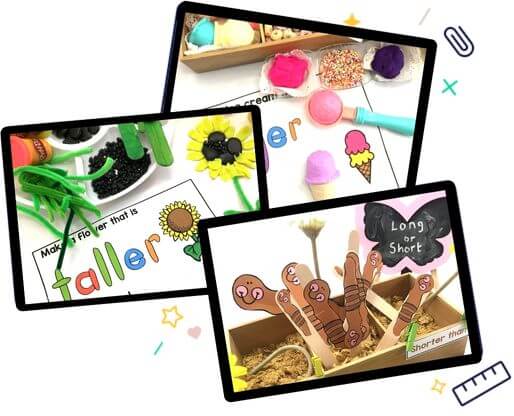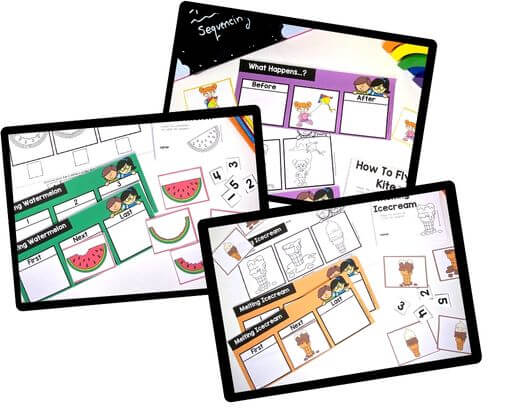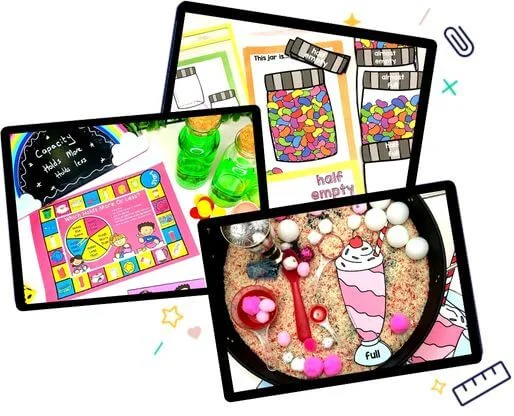Non-Standard Measurement For Kindergarten
Measurement Resources
Our Non-Standard Measurement For Kindergarten Teaching Resources will help build and explore EYFS measuring skills. Get some hands-on non-standard units of measurement lessons to make measuring length, mass and capacity a breeze!
Teaching measurement is possibly one of the most loved math concepts. Teachers love to teach it and kids love to learn it!
But the Measurement strand is HUGE and includes many concepts that are organised into:
- Using units of measurement – length, mass, capacity, volume, area, perimeter, time, temperature
- Shape – Attributes , nets, area of 2D Shapes & 3D Objects, Prisms and pyramids
- Location & Transformation – Prepositions, directions, flips, slides, turns, grid maps, symmetry, legends, translation, reflection, rotation, enlargements, tesselations, cartesian coordinate system
- Geometric Reasoning – Angles
WOW! Who knew there was so much to cover from K to Year 6?
In this post, we are focussing on Using Units of Measurement for Kindergarten and Pre-primary students.
Non-Standard Measurement For Kindergarten
In this post, we are focussing “Using Units of Measurements” for Kindergarten and Pre-primary students. This area of measurement is concerned with how to “measure” length, capacity, mass, volume, temperature and time.
Again, a massive amount of content to learn, but for EYFS students learning is centred on learning to measure using non-standard units of measurement, not standard units or measuring tools.
Before kids are introduced to Standard Measurement using rulers and measuring tapes they need to understand what is involved in the measuring process, which is why rulers are replaced with non-standard units, like popsticks, paperclips and counting cubes, to measure objects using non-standard measurement.
So what is non-standard measurement?
Quite simply, Non-standard measurement is using an informal unit to find out “how much” of something there is.
It’s a process taught to and used by students in Foundation, EYFS, Kindergarten, PrePrimary, Nursery, Reception and Year 1.
The purpose of non-standard measurement is to focus the child on key measuring skills rather than reading tricky scaled instruments. Non-Standard measurement helps kids learn to:
- select the right tool to measure the object being measured
- select the same unit and not different units when measuring an object
- measure without gaps or overlaps
- start and end the measuring in the right spots
- measure it straight
- be precise
Which Measuring Concepts Should You Teach?
As we said, the measurement concept is BIG, it includes teaching length, mass, capacity, volume, angles, temperature, area, perimeter, and time using non-standard units then Standard units and finally formula.
But don’t panic, teachers don’t need to teach EVERYTHING in every year level, and these concepts have been shared out across the K- Year 6-year levels as a continuum of learning.
So which measuring concepts should you be teaching in the Preschool, Kindergarten, Foundation or EYFS Years, I hear you ask? In a nutshell, early years teachers need to focus on teaching:
- length
- mass (weight)
- capacity
- time
- area (not in all states)
Click the images below for Hands-on measurement resources and details on how to teach each non-standard measurement concept in Kindergarten. (Preprimary, Foundation, EYFS)
Explore tags
EYFS Non-Standard Measurement Activities
Can't find what you're looking for?
Send us a request! Use this form to request a resource. Please give details of the learning area, topic, year level, curriculum links. We’ll be happy to take a look to see if we can fit it in. Unfortunately a request does not guarantee we will be able to make it!
"*" indicates required fields




